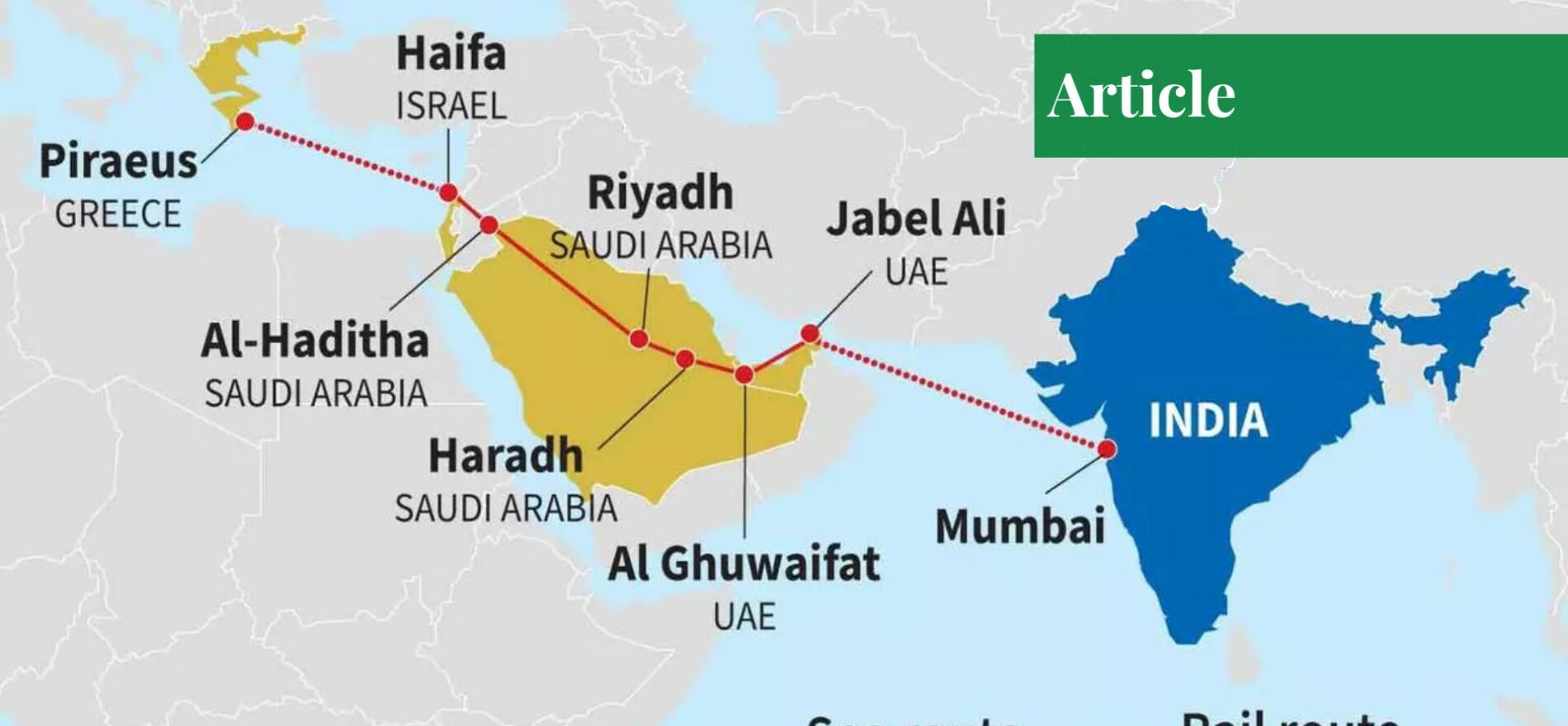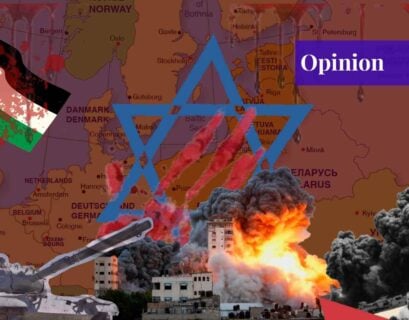Minahil Khalid is a student of M.Phil International Relations at Kinnaird College for Women University, Lahore. Her research interests revolve around global political issues and security studies.
The India-Middle East-Europe Economic Corridor (IMEC) has been introduced as an offset to China’s Belt and Road Initiative (BRI) and is expected to serve as an alternative to the Suez Canal as a trade route. Launched in September 2023 at the G20 summit in New Delhi, this corridor aimed to unveil the economic plans of world leaders from Saudi Arabia, the United Arab Emirates, the European Union, India, France, Germany, Italy, and the United States, after they signed a memorandum of understanding (MoU).
The plan of action indicates the uplifting of regional and global trade through the strengthening of transportation and communication links between Europe and Asia. The commitment of IMEC in moving towards introducing two distinct “corridors” showcases its strategic and economic importance, which can pose a threat to China’s BRI and consequently Pakistan, since Pakistan is a close ally of China.
However, regardless of the corridor’s geopolitical implications, it has faced a setback since the Israel-Palestine war on 7th October 2023. This conflict has caused complexities in the way of developing political and economic ties between Israel and the Middle East. In reality, the obstacles to this economic corridor are far more complicated than they seem, as it has yet to be backed up by strong investments.
Economic and Strategic Significance of IMEC
The MOU signed during the G20 summit highlights the vision of extensive energy and security goals for the European Nations. It was accompanied by an allowance for the United States to transform its national security goals, aimed at revitalizing regional and economic integration. During the summit, two separate corridors were proposed: the East Corridor and the North Corridor.
The Eastern Corridor would be responsible for linking India to the Arabian Gulf, whereas the Northern Corridor envisions the connection of the Arabian Gulf to Europe. In the Northern Corridor, the most visible infrastructural project is the operation of the UAE-Saudi Arabia-Amman railway network which would allow services and goods to be transported between Europe, India, the UAE, Jordan, Israel, and Saudi Arabia. This project also includes enhancing digital connectivity and pipes via electric cables to support a clean hydrogen project.
The IMEC is expected to bolster technology and energy partnerships between the involved nations. Strategic ties between India and Israel have been evident since they collaborated on military and technological programs. The partnership between the two states has strengthened since Prime Minister Narendra Modi came into power in India in the year 2014. The possession of the Haifa Port by the Adani Group highlights its importance as a trading hub, indicating a deeper integration of India into Europe and the Middle East. This key port is also crucial for the provision of an opportunity for Israel to create a trade route that would connect the Mediterranean and the Gulf, moving past the Suez Canal.
Apart from this, a 300-kilometer rail track is to be constructed under this corridor’s main infrastructural project that would create a connection between Amman and the port of Haifa. Moreover, strong trade volumes between India and Saudi Arabia prove the economic potential of this initiative. India and the UAE have also cemented an investment opportunity worth $15 billion, with trade standing at a whopping $85 billion.
The IMEC can further provide opportunities for Europe to expand its economic ties and help it cut back on its dependence on China. Ties between India and Europe may flourish as EU nations like France, Italy, and Germany have already transformed their relations with India, indicating the significance of the corridor in the EU’s vast strategic ambitions. Furthermore, if implementing IMEC sets its course, it can tremendously impact global trade dynamics.
Ships journeying through the Suez Canal may decline in number, causing a huge loss to nations like Egypt. The Suez Canal holds immense importance as 12% of global trade and 7% of global oil shipments are transported through it. So, even when new economic opportunities for nations involved in the corridor may be initiated, it would severely impact the economic interests of Egypt due to its heavy reliance on the Suez Canal.
Besides this, IMEC is mostly considered a response to China’s rising global ambitions. The Gulf states as a part of the corridor are determined to maintain a geopolitical and economic balance in their ties with China, the West, and Russia. They view the IMEC as an initiative that could boost their relations and reliance on global production networks.
Obstacles to the Implementation of IMEC
The start of the Israel-Palestine war changed the course of the initiatives that were to be taken under IMEC, making it a complicated venture to establish economic and political connections between Israel and the Middle Eastern nations. The war has also resulted in the delaying of a minilateral meeting of the I2U2 (a partnership between India, Israel, the UAE, and the U.S.) scheduled for October.
With the escalation of tensions, the nations involved in the IMEC also failed to initiate a meeting within sixty days for the development of an IMEC plan of action, which had been discussed during the G20 summit. This indicates that the development of diplomatic relations between the nations has become a complex issue. Although the eastern and northern corridors were announced successfully alongside several other projects, the nations involved are yet to form a consensus regarding the funding of said projects. They require billions in funding and the total could add up to $20 billion. It can be deduced from this that the IMEC lacks clarification for its financing.
Moving on, several geopolitical concerns can become a challenge for the implementation of this corridor. These include tensions between nations, such as the dispute between India and Pakistan, the Saudi-Iran rivalry, and ongoing conflicts in Yemen and Syria. In addition to these, the geographical location of Iran concerning the Strait of Hormuz may also impede the effective functioning of this corridor.
Even though the IMEC is aimed at counterbalancing BRI, China may cause a diversion of investments and trade towards IMEC which can serve as a potential challenge to the corridor’s stability and security. The development of trust between the involved nations is yet to be seen as Europe’s major concerns revolve around certifying that the infrastructural projects under the IMEC will not be used or exploited to benefit Russia or China’s influence. These European concerns seem pertinent due to the rise of China’s control in the Middle East accompanied by Russia’s increased role in the region.
Lastly, the exclusion of regional actors such as Turkiye, Oman, and Iraq can consequently raise opportunities for the creation of alternative competing projects. It can hinder diplomatic relations, as indicated by President Erdogan’s statement, “There can be no corridor without Turkey.” These countries could have served as a geographical benefit for the corridor, and their exclusion may cripple its successful implementation. Without meticulous observation of these obstacles, the smooth functioning of this corridor will remain at risk.
Scrutinizing Potential Challenges for Pakistan
The IMEC may give rise to several issues and challenges for Pakistan considering India’s competition with Pakistan and China. Pakistan’s involvement in the China-Pakistan Economic Corridor (CPEC) has enabled the nation to have control over crucial land that has impeded India’s relations with European nations and the Middle East.
The IMEC may allow India to surpass Pakistan by hindering its geopolitical influence in the region. If this corridor becomes a major transportation route, then it can cause regional isolation for Pakistan and this isolation may even escalate over time. The economy of Pakistan is already in turmoil and the newly proposed initiatives of the IMEC might take the trade and investment opportunities further away from it. This corridor’s strategic interests can threaten Pakistan’s foreign policy and regional relations as it has established its aims and objectives with major powers like the U.S. and the European Nations.
IMEC’s associated projects work as a countermeasure to China’s BRI. Pakistan is a close ally of China. This situation may bring Pakistan to odd terms with the strategic and economic ambitions of the IMEC, consequently weakening the nation’s diplomatic and regional relations. To prevent these potential pitfalls, Pakistan needs to come up with a meticulously devised plan for engaging with the new economic networks introduced by IMEC. It might also need to bring forward new policies that would strengthen the nation’s regional, economic, as well as trade relations to fend off any hostilities from IMEC.
Conclusion
It can be deduced that IMEC is of major importance to the nations involved as it has a significant potential for boosting strategic and economic ties. It proposes cooperation and connection between the Persian Gulf, Asia, and Europe while aligning with the European Union’s Indo-Pacific strategy and paving the way for the diversification of economic relations between states.
IMEC may offer plenty of potential economic benefits on a regional and international level however, such goals cannot be achieved if certain challenges and obstacles are not addressed. The rising influence of China and Russia in the region raises concerns over the implementation of the corridor. Finally, geopolitical tensions such as the Indo-Pakistani dispute, the Saudi-Iran rivalry, and more are yet to be navigated. When viewed from Pakistan’s perspective, these potential challenges may create regional complexities that need to be reassessed and addressed.
If you want to submit your articles and/or research papers, please check the Submissions page.
The views and opinions expressed in this article/paper are the author’s own and do not necessarily reflect the editorial position of Paradigm Shift.



















